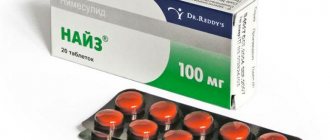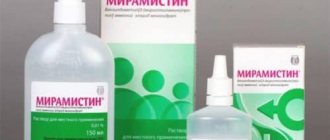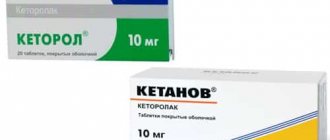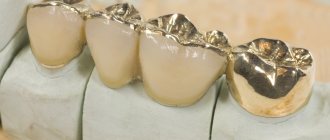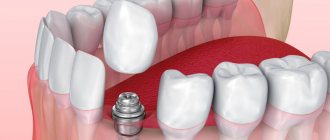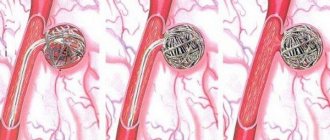Ketonal injections are a popular medication in the complex treatment of diseases of the musculoskeletal system. The medicine belongs to the group of non-steroidal anti-inflammatory drugs. The solution in ampoules is used for intramuscular and intravenous administration.
"Magic" pills
There is a group of drugs collectively called non-steroidal anti-inflammatory drugs (NSAIDs), which we all have taken at least once in our lives, and many regularly. These are drugs that have analgesic, anti-inflammatory and/or antipyretic effects. Examples include Aspirin, Nurofen, Nice, Ketanov, Ketoprofen and others. Considering the “magical effects” of their action - relieving inflammation, pain and fever - they are prescribed by almost everyone, everyone, always. Prescribed by traumatologists, rheumatologists, therapists, ENT specialists, dentists. Plus, they can be purchased completely freely at any pharmacy. But, along with the “magical properties”, these drugs have a number of side effects that can be divided into 2 groups: cardio risks and gastro risks. Actually, gastrorisks will be discussed in this article.
Ketorol
Ketorol is a drug belonging to the class of NSAIDs (non-steroidal anti-inflammatory drugs). Kerolol is also known by the name of its active ingredient (Ketorolac). Between Ketoro and Ketorolac you can put an equal sign in the same way as between Ketonal and Ketoprofen, mentioned above. Ketorol exhibits the following effects:
- Anesthetic.
- Antipyretic.
- Anti-inflammatory.
In practice, analgesic and anti-inflammatory effects are of greatest importance. The release forms of Ketorol do not differ from those of Ketonal.
The action of Ketorol is also based on the inhibition of COX enzymes (cyclooxygenase-1 and cyclooxygenase-2). Indications for use of Ketorol:
- Migraine pain.
- Toothache.
- Postoperative period (pain in the area of postoperative wounds).
- Oncological diseases.
- Rheumatism.
- Pain in inflamed joints.
- Neurological pain.
- Severe pain during menstruation.
NSAID gastropathy
In the scientific literature, this problem is called “NSAID gastropathy.” The term was first proposed in 1986 to distinguish specific damage to the gastric mucosa that occurs with long-term use of NSAIDs from classic peptic ulcer disease.
The difference between NSAID gastropathy and peptic ulcer disease can also be traced by the affected area. Most often, ulcers can be seen in the stomach, and not in the duodenum. Plus, the changes are more common in older people than in younger people.
Some numbers
Some statistics. In the UK, approximately 24 million NSAIDs are prescribed per year. 70% of people over 70 years of age take NSAIDs once a week, and 34% daily. In the United States, up to 6 billion worth of NSAIDs are sold annually. As a result, the risk of developing gastrointestinal bleeding (GIB) increases 3–5 times, perforation by 6 times, and the risk of death from complications by up to 8 times. Up to 40–50% of all cases of acute gastrointestinal tract infections are associated with NSAIDs.
This problem is also relevant in our country, for example, according to the Scientific Center for Cardiovascular Surgery named after. A.N. Bakulev, out of 240 patients taking aspirin daily, even in small doses, gastroscopy revealed lesions of the stomach and 12 p.c. in 30% (of which ulcers - in 23.6%, erosions - in 76.4%). A similar picture was observed among colleagues from the All-Russian Research Institute of Rheumatology of the Russian Academy of Medical Sciences - in 2126 patients taking NSAIDs without “covering” (protection) of the stomach, erosions and ulcers of the gastroduodenal zone were found in 33.8% of cases. These are very impressive and dramatic numbers of complications from taking NSAIDs, considering the number of people using these drugs in developed countries.
Description of "Ketorola"
The main active ingredient is ketorolac. The drug is available in the form of tablets, solution and gel. The medication quickly relieves fever and inflammation, and also has analgesic properties.
The drug effectively combats acute pain that occurs for various reasons:
- – after performing medical procedures;
- – burns;
- – injuries;
- – headache, migraine;
- - toothache;
- – colic in the liver and kidneys;
- – pain caused by sickle cell anemia;
- – neuritis;
- – neuralgic diseases;
- – herpes zoster syndrome.
Ketorol does not treat chronic pain. Not prescribed to patients with the following disorders:
- – personal intolerance to the components of the drug;
- – aspirin asthma;
- – stomach ulcer;
- – renal failure;
- – hemostasis;
- – hemorrhagic stroke;
- – congestive heart failure.
Restrictions:
- – pregnancy and lactation;
- – children under 16 years of age.
Adverse reactions may occur if the recommendations for use are not followed:
- - abdominal pain;
- – dyspeptic symptom;
- – drowsiness;
- – allergic manifestations;
- – emotional disorder.
Essentiale or Heptral, which is better?
How it works?
How do these drugs work in our stomachs? Everything is very simple, the negative impact is realized due to the imbalance of defensive and aggressive forces. We have a number of defense mechanisms in our stomach that allow us to withstand the onslaught of aggressors. Among the latest:
- An acid whose pH balance is close to that of battery acid
- Bile and pancreatic juice, which can be thrown into the stomach.
- A number of medications.
- Alcohol and nicotine.
- Irritating food components (spices, spicy foods, etc.)
- Helicobacter pylori infection and so on.
The stomach is protected due to a thick layer of mucus and bicarbonates that neutralize acid, adequate blood supply, and the ability to regenerate very quickly. When we use NSAID drugs, the balance of forces changes towards aggressive mechanisms and damage occurs to the mucous and submucosal layer of the stomach and duodenum.
Diagnostics
To diagnose such changes, gastroscopy is used, which is the “gold standard”. An interesting fact is that about 40% of patients with erosive-ulcerative changes who take these drugs for a long time (more than 6 weeks) do not feel any discomfort or unpleasant, painful sensations. Stomach problems are diagnosed only when visiting other doctors, and not a gastroenterologist. And, conversely, in 40% of patients, despite the complaints they make, nothing is found.
What do they have in common?
Thus, we can conclude that these two drugs are very close to each other . They are united by such characteristics as:
- Presence of analgesic effect.
- The presence of anti-inflammatory action.
- The same mechanism of action is inhibition of the activity of cyclooxygenase enzymes.
- Identical release forms.
- Over-the-counter release from pharmacies. Ketorol and Ketonal are equally accessible, since anyone can purchase these drugs without a doctor's prescription.
- Similar indications for use (some).
- Proven effectiveness.
- Rapid onset of effect.
What to do in this case?!
The algorithm of actions for patients who do not have stomach problems and those who have a history of peptic ulcers or erosive changes is different. For the first group, when prescribing non-steroidal anti-inflammatory drugs for more than 5 days, it is mandatory to prescribe drugs from the group of proton pump inhibitors (PPIs). Such as omeprazole, pantoprazole, rabeprazole, etc. (for the entire course of treatment). For the second group, any prescriptions from the NSAID group, regardless of the duration of use, require parallel prescription of proton pump inhibitors. It is also mandatory to take a PPI for patients taking aspirin for a long time.
Differences between Ketonal and Ketorol
However, despite the seemingly absolute identity of these drugs, they also have a number of differences, due to the presence of which it is completely erroneous to identify them with each other.
First of all, you need to focus on the fact that Ketorol is undoubtedly a more powerful remedy than Ketonal. The effect of Ketorol occurs faster in time, it is stronger and longer lasting if we analyze the use for the same condition. In some cases, for example, with cancer, severe dental pain, postoperative pain, Ketonal will not have an analgesic effect at all.
Ketor also has a more pronounced anti-inflammatory effect (which is why it is included in the class of non-steroidal anti-inflammatory drugs, unlike Ketonal) and antipyretic effect (Ketonal does not have this at all).
The greater power of the drug "Ketorol" entails a wider range of side effects. These are similar to the side effects of Ketonal, but they are more severe and more common. A similar picture exists with contraindications.
Myths that we encounter in daily practice
Myth 1. Using NSAID drugs in the form of suppositories is less aggressive for the stomach than taking pills
This is 100% a myth. The pathogenic, destructive effect of the drug is realized through the blood, delivering it through the vessels to the stomach.
Myth 2. Medicines from the group of antacids - Rennie, Maalox, Phosphalugel and H2-blockers (Ranitidine and Famotidine) can be used as “gastroprotectors”
In this case they are not effective.
Myth 3. You can't take proton pump inhibitors regularly
The fact is that if an elderly person has been prescribed an anti-inflammatory drug for life, it is absolutely pointless to prescribe gastroprotection for a month. In such cases, medications should be taken strictly in parallel.
Myth 4. Food products (jelly, etc.) can act as “gastroprotectors”
We will leave this myth as absolutely fantastic without comment.
"Ketorol" and "Ketanov": what is the difference and how do they differ?
The drugs have certain similarities and differences. Are they the same thing or not and what is the difference between them.
How are they similar?
The medications contain one active ingredient. They also have the same restrictions and indications for use. The drugs belong to the group of non-steroidal anti-inflammatory drugs. Both come in tablet, injection, and gel forms.
Which is better, Urolesan or Cyston
What is the difference
The main difference is that it is manufactured by the Indian pharmaceutical corporation S.K.Therapy S.A. "Ketorol" - Indian pharmaceutical.
Which is better and stronger? Which drug is more effective?
A stronger medicine is Ketanov. It is prescribed for severe burns or injuries. Ketorol glues platelets together, so it is best taken for quick healing of cuts, stitches and wounds.
- When choosing a medication, be sure to familiarize yourself with the contraindications. "Ketanov" has more restrictions.
- It is safer to use Ketarol during pregnancy and lactation. However, this should not be done without a doctor's prescription.
Price policy
- “Ketarol” in tablets can be bought for 40 rubles, an injection solution for 135 rubles, and a gel for external use for 250 rubles.
- “Ketanov” in tablets costs 50 rubles, an injection solution can be bought for 100 rubles, a cream for 320 rubles, and a gel for 350 rubles.
Cream and gel can be bought at a pharmacy without a doctor's prescription. Drugs in the form of ampoules and tablets are sold only with a prescription.
How to choose a medicine
In fact, the most important point is which medications we take. In the figure you can see the scale of aggressiveness of various drugs from the NSAID group in relation to the stomach.
The most aggressive drugs are Aspirin, Ketorolac, Piroxicam, Indomethacin. If possible, it is recommended to use selective drugs that have minimal gastrointestinal risks. Their use is always more desirable, these include Celecoxib and Rofecoxib. But despite their relative safety, they should be prescribed strictly according to indications by the attending doctor, do not forget about this.
